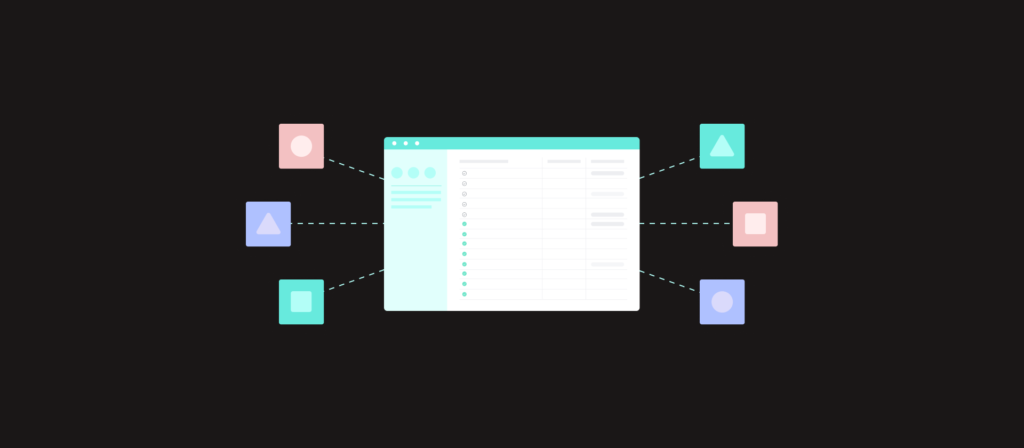As organizations continue to adopt more specialized applications, ensuring that these tools work together seamlessly has become increasingly important. Integration middleware is key to connecting these diverse applications, whether they are cloud-based or on-premises. By leveraging integration middleware, businesses can enable their applications to communicate effectively, supporting employees, customers, and overall business objectives.
In this article, we’ll guide you through everything you need to know about integration middleware and how it can help your organization.

Ready to integrate your applications?
Learn how Workato, the leader in enterprise automation, can help by scheduling a demo with one of our automation experts.
What is integration middleware?
Integration middleware is a third-party software solution that facilitates the connection and communication between two or more applications within an organization’s IT ecosystem. These applications can range from modern cloud-based solutions, such as SaaS (Software as a Service) applications, to legacy on-premises systems, like traditional databases or enterprise resource planning (ERP) software.

Integration middleware enables disparate systems to exchange data and commands without requiring each application to be directly connected to every other application in the network. This not only simplifies the integration process but also makes it more scalable, as new applications can be added or removed with minimal disruption.
Types of Integration Middleware or Integration Middleware Solutions
Integration middleware solutions come in various forms, each catering to different organizational needs and IT environments. There are two primary types of integration middleware: Enterprise Integration Platform as a Service (EiPaaS) and Enterprise Service Bus (ESB).
1.Enterprise Integration Platform as a Service (EiPaaS)
An Enterprise Integration Platform as a Service (EiPaaS) is a cloud-based solution that provides a comprehensive platform for integrating applications, data, and processes across an enterprise. EiPaaS solutions are designed to facilitate the seamless flow of data between on-premises systems, cloud-based applications, and mobile devices, making them an essential tool for modern businesses that operate in diverse and complex IT environments.
Why are asynchronous and synchronous messaging transmission types important in an EiPaaS?
Messaging transmission types—asynchronous and synchronous—play a critical role in how data and commands are exchanged between integrated applications in an EiPaaS.
- Asynchronous Messaging: In this mode, messages are sent and received independently of the application’s main process flow. This is crucial in scenarios where tasks need to be decoupled to prevent bottlenecks, allowing the system to continue processing other tasks while waiting for a response.
- Synchronous Messaging: Synchronous messaging, on the other hand, requires the sender to wait for a response from the receiver before continuing with the process. This method is vital for real-time processes where immediate feedback is necessary, such as in financial transactions or live data monitoring.
Why does an EiPaaS need fully managed service and robust user management?
An EiPaaS typically operates as a fully managed service, meaning that the cloud provider takes care of the underlying infrastructure, security, updates, and maintenance. This is crucial for several reasons:
- Scalability and Reliability: A fully managed service ensures that the platform can scale to meet the demands of the business without the need for significant manual intervention. It also guarantees high availability and reliability, which are essential for mission-critical integrations.
- Focus on Core Business: By offloading the management of the platform to the service provider, organizations can focus on their core business activities instead of worrying about the technical complexities of maintaining the integration platform.
- Robust User Management: EiPaaS platforms typically offer robust user management features, including role-based access control (RBAC), which is essential for enforcing security policies and ensuring that users have the appropriate level of access. This helps prevent unauthorized access to sensitive data and ensures compliance with data protection regulations.
What are some common features of EiPaaS products?
EiPaaS products come equipped with a variety of features designed to streamline integration processes and enhance productivity. Some common features include:
- Pre-built Connectors: These allow for quick and easy integration with popular applications and services without the need for extensive custom coding.
- Data Transformation Tools: EiPaaS platforms typically include tools for transforming data from one format to another, ensuring compatibility between different systems.
- Orchestration and Workflow Automation: These features enable the automation of complex business processes across multiple applications, reducing the need for manual intervention and minimizing errors.
- Real-time Monitoring and Analytics: EiPaaS solutions often provide real-time monitoring of data flows and integration processes, along with analytics tools that help identify and resolve issues proactively.
2. Enterprise Service Bus (ESB)
Enterprise Service Bus (ESB) is another type of integration middleware that acts as a centralized communication hub within an organization’s IT ecosystem. It uses a “bus” architecture to manage communication between various applications, allowing them to exchange data in a standardized format.
An ESB handles tasks such as message routing, data transformation, and protocol conversion, ensuring that different applications can communicate effectively regardless of their underlying technology. This is particularly beneficial in complex, enterprise-level environments where multiple applications need to interact in a coordinated manner.
How Does Integration Middleware Work?
Integration middleware acts as a mediator that facilitates communication and data exchange between different applications within an organization’s IT environment. It helps to integrate various systems by providing a set of services that manage data flow, ensure compatibility, and maintain data integrity across applications. Let’s explore how integration middleware operates and the critical components involved in this process.
Merge in the context of middleware integration
In the context of middleware integration, merge refers to the process of combining data from different sources into a unified format or system. This involves the aggregation of data from multiple applications, transforming it into a consistent structure, and then delivering it to a destination system. Merging is particularly useful when dealing with disparate data formats and protocols, ensuring that all integrated systems can understand and utilize the data effectively.

For example, an organization might use middleware to merge customer data from its CRM system with order data from its ERP system. The middleware would extract the necessary data from both systems, transform it into a unified format that both systems can understand, and then merge the data to provide a consolidated view of customer interactions and order history. This merged data can then be used for various purposes, such as generating reports, enhancing customer service, or making data-driven business decisions.
Benefits of using integration middleware
While traditional middleware platforms offer significant advantages in connecting diverse applications, they often come with limitations. Despite these drawbacks, modern integration middleware solutions, like Enterprise Integration Platform as a Service (EiPaaS) and Enterprise Service Bus (ESB), provide enhanced features and capabilities that address the shortcomings of traditional platforms. Here are some of the key benefits of using integration middleware:
1. It lets you avoid point-to-point integrations
Point-to-point (P2P) integrations, or the use of custom code to stitch together applications, is fraught with issues:
- Your developers have to invest a significant amount of time on building to applications’ APIs and in maintaining those connections—taking them away from other business-critical tasks they’re uniquely suited to perform.
- You’re forced to over rely on select developers; only they know where the code lives and how to troubleshoot and improve integrations. As a result, when they leave your company, the long-term performance of your integrations will likely be affected.
- You’re unable to implement new integrations fast enough; your developers may be tasked with higher priority projects or find that the scope of build is extensive.
Fortunately, using a middleware platform, you don’t need to adopt this approach and risk experiencing any of these challenges.
2. It often exceeds native integrations’ capabilities
Native integrations, or integrations that the applications themselves make available, are also far from perfect.
- The provider likely makes only a handful of integrations accessible, preventing your organization from implementing the majority that are needed.
- The provider may fall short of your expectations when it comes to enhancing or fixing the integrations over time. After all, they also have engineers who face competing priorities—and integrations likely aren’t at the top of their lists.
3. It offers enterprise-grade security and governance
Middleware tools, particularly iPaaS solutions, have a track record of protecting sensitive, business-critical data effectively. For example, many vendors comply with a variety of data protection and privacy laws and regulations, from HIPAA to GDPR. In addition, they can help you enforce the principle of least privilege (users only get access to the data they absolutely need) through features like role-based access control.
Related: How to perform data streaming
Examples of using integration middleware
Integration middleware is often used in one of two ways: application integration and data integration. Let’s review each use case with concrete examples.
1. Integrating your CRM and ERP system
You’ll need to enable interoperability between your CRM and ERP system to invoice clients quickly.
To help facilitate this need, you can integrate a CRM like Salesforce with an ERP System like NetSuite and implement and following workflow:
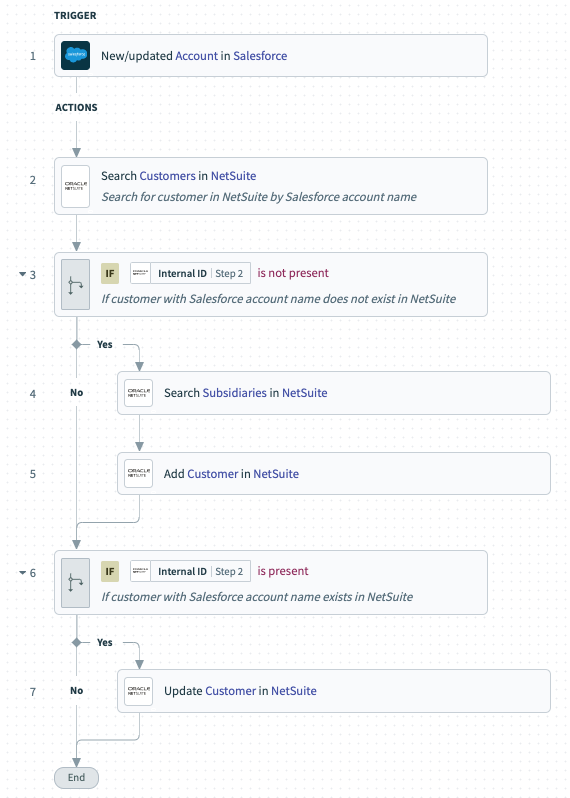
1. Once an account is updated or created in Salesforce, the workflow gets triggered. 2. The middleware software checks to see if the customer already exists in NetSuite. a. If it does, it updates the customer based on the changes made in Salesforce. b. If it doesn’t, it adds the customer and updates it according to the changes made in Salesforce.
Popular Salesforce integrations
2. Implementing a customer 360
Let’s say that as part of your approach to data management, you want to create a single source of truth for customer data (i.e. a customer 360). This involves using a middleware tool to adopt an ETL process:
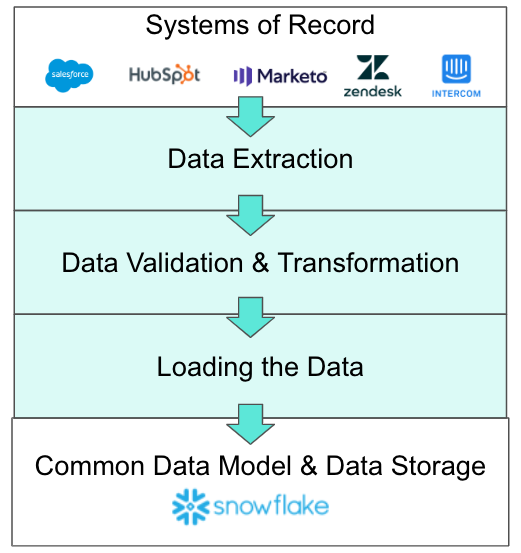
1. Extract specific data from source systems that host customer information—an ITSM tool, CRM, marketing automation platform, live chat tool, etc. 2. Validate the data to remove duplicates and inaccuracies and transform its data model to what your data warehouse uses. 3. Load the data into your data warehouse. Your analysts can then pull the data into their business intelligence and analytics tools, and your customer-facing teams can receive the data in their business applications in real time—all but ensuring that it’s valuable to them.
Related: How to implement a customer 360
Where traditional middleware platforms fall short
Despite its benefits, middleware often comes with drawbacks.
User experience
Middleware tools normally require a certain level of technical expertise from its users; this precludes the majority of your employees from using them, and, as a result, makes it difficult for your organization to implement integrations at scale. Over time, this leads to significant integration backlogs, lengthy delivery timelines, and a worsened relationship between IT and lines of business.
Unfortunately, we see this playing out in the real-world: When surveying hundreds of BT professionals as part of our State of Business Technology, we found that speed of delivery (which includes providing integrations) and integration/automation tools were the biggest frustrations in their role.
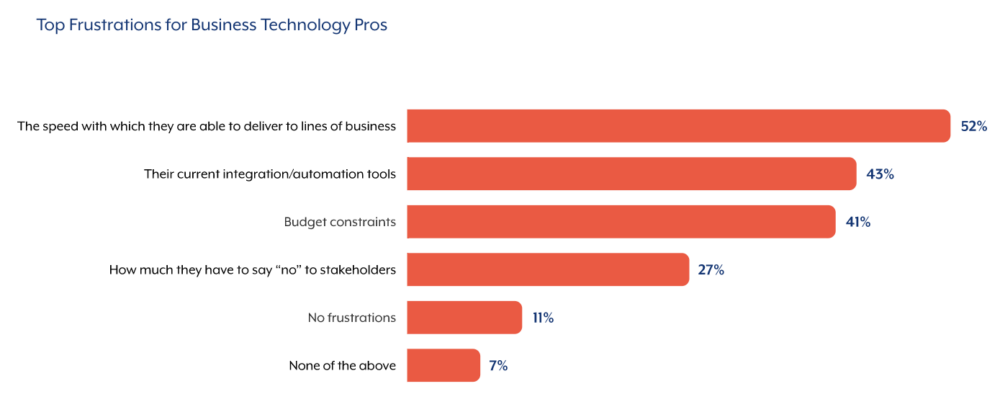
End-to-end automations
While there’s clearly value in syncing data between applications and automating mundane, time-consuming tasks, your organization needs to go further to truly innovate and transform. More specifically, you need to automate your business processes end-to-end, whether it’s quote to cash, lead routing, incident management, etc.
Traditional middleware tools fall short of providing this functionality, as they rely exclusively on connectivity.
Related: Where data orchestration tools fall short
Built-in bot framework
Providing employees the data they need within their applications isn’t enough.
To help them avoid hopping between applications and move faster, you’ll need a platform bot that can communicate between your business communications platform (e.g. Slack) and the applications your employees rely on. Once implemented, employees can access their applications’ functionality and data in just a matter of clicks within their business communications platform.
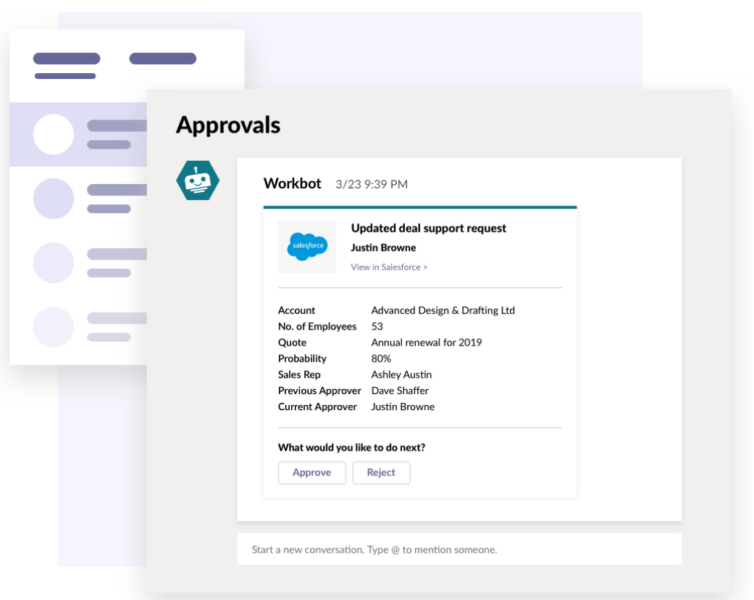
Like the previous drawbacks, classic middleware tools have yet to offer up this capability.
At this point, you might find yourself wondering: Is there a platform that includes the benefits of traditional middleware solutions AND accounts for their drawbacks?
The answer takes the form of an enterprise automation platform.
Using this type of platform, your employees can access a low-code/no-code UX, enterprise-grade governance and security features, hundreds of thousands of automation templates and hundreds of pre-built connectors—and much, much more.
